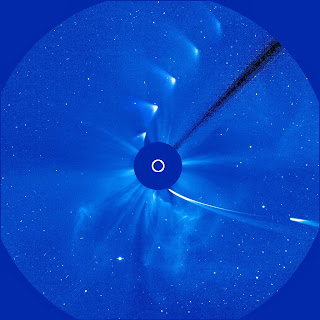 |
| Comet ISON (upper left) rises before dawn falls upon the 1909 Blasdel Barn, near Kalispell (click to enlarge) |
On another scale - one that, I think, puts our human endeavors in their proper place - when this old barn was built, Comet ISON was already 4.6 billion year old, give or take. On its first and only trip through our solar system, ISON is on a slingshot course around our sun. If it survives today's encounter, it will be flung back out into deep space, never to return.
In the next 24 hours, ISON will skim a mere 700,000 miles above the solar surface - a distance that's less than the sun's diameter. An incredible amount of solar radiation is blasting and aging the comet quickly. From a rock/ice core that's just over one mile wide, ISON's ice is being vaporized into a fuzzy "coma" that's about 80,000 miles wide, with a tail of dust and vapor that's 5 million miles long, pushed away from the sun. One astronomer calculated that the sun is blowing away 3 tons of comet material per second.
As ISON passes the sun, it will reach a top speed of 225 miles per second, or more than 1500 times faster than a commercial jet, which would cross the U.S. in 15 seconds at that speed. I'm not quite sure if there's a way to calculate how this compares to the speed of the horse-drawn stage that used to pull into the oversized passage, through the heart of the Blasdel Barn.
Like the days of horse power, this comet encounter will soon pass and never come back 'round. Enjoy it while you can.
----------------------------------------------------------------------------
 |
| Comes in as a comet (right), departs as a dust cloud (top). SOHO Image by NASA (click for video) |
Highlights of Comet ISON from NASA Science News.
Text version can be read here.
ISON at perihelion

